Well-to-Wheels for Light-Duty Vehicle Powertrains by Segments in Isolated Systems †
Abstract
1. Introduction
2. Methods
2.1. Methodology Background
2.2. Literature Review
2.3. WtW Modeling: The Canary Island Case Study
2.3.1. Aim and Scope
- Material extraction and transportation to build car components and their transportation to the automobile assembly centers; excluded mainly due to the lack of information from the manufacturers and material providers for each car model.
- End-of-life alternatives; there are several ways to reduce the impact by extending the life of vehicles or their components, but this depends on multiple parameters and exceeds the aim of this work.
2.3.2. WtW Modeling
2.3.3. Fuel Pathway in the Canary Islands
2.3.4. Canary Islands Electrical Systems and Scenarios
2.3.5. Canary Islands Light-Duty Vehicles Inventory
3. Results
3.1. Well-to-Wheels Results for Internal Combustion Engine and Hybrids Cars
3.2. Well-to-Wheels Results for Plug-In Electric Vehicles for Current Scenarios
3.3. Well-to-Wheels Results for Plug-In Electric Vehicles for Future Energy Transition Scenarios
4. Discussion and Policy Implications
5. Conclusions
- The advantages of PEVs as a mitigator of equivalent emissions are partially lost as a result of the use of oil derivatives in electricity generation. The impact on the environment of PEVs depends significantly on the cleanliness of the electricity production.
- BEVs are a better alternative than an ICEV gasoline average car when the electricity mix surpasses 6% from renewables or 15% to improve the HEV figures.
- The breakout point for PHEVs requires over 35% renewable energy mixes to improve the ICEV gasoline results.
- For Tenerife and Gran Canaria (bigger systems), BEVs remain as the preferred solution to reduce WtW impacts.
- In midsize systems (Fuerteventura–Lanzarote and La Palma), BEVs return similar results to HEVs.
- La Gomera represents the worst case for PEVs due to the scarcity of renewable facilities on the island.
- El Hierro represents an early energy transition island and PEVs offer a potential reduction of 66% in comparison to gasoline cars.
- In the Tenerife system, the influence of photovoltaics causes a large reduction in the GHG emissions for PEVs when these are plugged in during mid-peak hours.
- Conversely, on El Hierro, off-peak charging during the night potentially reduces the WtW impacts of PEVs. For the remaining islands, the charging schedule does not have a significant impact on the WtW.
- The most popular cars sold today (SUVs) are the greatest polluters of all segments. On average, these cars produce 6% more impacts (energy consumption and emissions) than those in the A, B, and C segments (urban and compact cars).
- In the sub-optimal renewable-share scenarios (below 6%), BEVs could be equal to or more polluting than some ICEVs in the current scenarios. Thus, in most scenarios, BEVs improved the figures of all ICEV technologies in the Canary Islands.
- PHEVs require greener mixes (more than 35% of renewable energy) to improve the equivalent emissions of ICEVs (gasoline or diesel). However, PEVs have become the best solution for achieving a reduction of about 60% in CO2 in the roadmap to 2030 scenarios. Nevertheless, it is also important to note that PEVs do not pollute locally, reducing dangerous gases in cities.
- Future research in this area should focus on how the charging management influences the WtW impacts on isolated systems to promote initiatives to reduce the impact of PEVs.
Author Contributions
Funding
Institutional Review Board Statement
Informed Consent Statement
Data Availability Statement
Acknowledgments
Conflicts of Interest
References
- Delbeke, J.; Runge-Metzger, A.; Slingenberg, Y.; Werksman, J. The Paris Agreement. In Towards a Climate-Neutral Europe; Routledge: Oxfordshire, UK, 2019; pp. 24–45. [Google Scholar] [CrossRef]
- European Commission. The European Green Deal; European Commission: Brussels, Belgium, 2019; pp. 47–65. [Google Scholar]
- European Commission. Europe on the Move: Commission Completes Its Agenda for Safe, Clean and Connected Mobility; European Commission: Brussels, Belgium, 2018; Volume 2050. [Google Scholar]
- European Commission, Directorate-General for Budget. EU Budget Policy Brief: The EU as an Issuer: The NextGenerationEU Transformation; European Commission: Brussels, Belgium, 2022. [Google Scholar]
- International Energy Agency. Tracking Transport 2020; International Energy Agency: Paris, France, 2020. [Google Scholar]
- International Energy Agency. Global EV Outlook 2021; International Energy Agency: Paris, France, 2020. [Google Scholar]
- European Commission. Sustainable & Smart Mobility Strategy; European Commission: Brussels, Belgium, 2020. [Google Scholar]
- European Parliament. Regulation (EU) 2019/631 of the European Parliament and of the Council of 17 April 2019, Setting CO2 Emissions Performance Standars for New Passenger Cars and for New Light Commercial Vehicles, and Repealing Regulations (EC); European Parliament: Brussels, Belgium, 2019; Volume 10, pp. 1–21. [Google Scholar]
- U. S. Energy Information Administration. Global Transportation Energy Consumption: Examination of Scenarios to 2040 Using ITEDD; U.S. Energy Information Administration: Washington, DC, USA, 2017. [Google Scholar]
- Maldonado, E. Energy in the EU Outermost Regions (Renewable Energy, Energy Efficiency)—Final Report; European Comission: Brussels, Belgium, 2017; pp. 1–21. [Google Scholar]
- Gobierno de Canarias. Anuario Energético de Canarias 2020; Gobierno de Canarias: Las Palmas de Gran Canaria, Spain, 2021. [Google Scholar]
- BOE Ley 7/2021, de 20 de Mayo, de Cambio Climático y Transición Energética. Boletín Of. Estado 2021, 121, 26798–26800.
- MITECO. Plan Nacional Integrado de Energía y Clima 2021–2030; Ministerio para la Transición Ecológica y el Reto Demográfico: Madrid, Spain, 2020; p. 25. [Google Scholar]
- Gobierno de Canarias. Preeliminary PTECan; Gobierno de Canarias: Las Palmas de Gran Canaria, Spain, 2021. [Google Scholar]
- Jensen, A.A.; Elkington, J.; Christiansen, K.; Hoffmann, L.; Møller, B.T.; Schmidt, A.; van Dijk, F. Life Cycle Assessment (LCA)—A Guide to Approaches, Experiences and Information Sources; European Environment Agency: Copenhagen, Denmark, 1997. [Google Scholar]
- Prussi, M.; Yugo, M.; De Prada, L.; Padella, M.; Edwards, M. JEC Well-To-Wheels Report V5; Publications Office of the European Union: Luxembourg, 2020; ISBN 9789276201090. [Google Scholar]
- López, A.I.; Ramírez-Díaz, A.; Rodriguez, I.; Gurriarán, J.; Mendez-Perez, J.A. Wind Farm Energy Surplus Storage Solution with Second-Life Vehicle Batteries in Isolated Grids. Energy Policy 2023, 173, 113373. [Google Scholar] [CrossRef]
- Ioakimidis, C.S.; Murillo-Marrodán, A.; Bagheri, A.; Thomas, D.; Genikomsakis, K.N. Life Cycle Assessment of a Lithium Iron Phosphate (LFP) Electric Vehicle Battery in Second Life Application Scenarios. Sustainability 2019, 11, 2527. [Google Scholar] [CrossRef]
- Shen, W.; Han, W.; Chock, D.; Chai, Q.; Zhang, A. Well-to-Wheels Life-Cycle Analysis of Alternative Fuels and Vehicle Technologies in China. Energy Policy 2012, 49, 296–307. [Google Scholar] [CrossRef]
- Moro, A.; Helmers, E. A New Hybrid Method for Reducing the Gap between WTW and LCA in the Carbon Footprint Assessment of Electric Vehicles. Int. J. Life Cycle Assess. 2017, 22, 4–14. [Google Scholar] [CrossRef]
- Sivak, M.; Schoettle, B. Fuel Sources for Electricity in the Individual Countries of the World and the Consequent Emissions from Driving Electric Vehicles; The University of Michigan: Ann Arbor, MI, USA, 2017. [Google Scholar]
- Ke, W.; Zhang, S.; He, X.; Wu, Y.; Hao, J. Well-to-Wheels Energy Consumption and Emissions of Electric Vehicles: Mid-Term Implications from Real-World Features and Air Pollution Control Progress. Appl. Energy 2017, 188, 367–377. [Google Scholar] [CrossRef]
- Haugen, M.J.; Paoli, L.; Cullen, J.; Cebon, D.; Boies, A.M. A Fork in the Road: Which Energy Pathway Offers the Greatest Energy Efficiency and CO 2 Reduction Potential for Low-Carbon Vehicles? Appl. Energy 2020, 283, 116295. [Google Scholar] [CrossRef]
- García-Afonso, Ó.; Santana-Méndez, I.; Delgado-Torres, A.M.; González-Díaz, B. On the Road to a Sustainable Transport Mobility in Isolated Power Systems: The Role of Light-Duty Powertrain Electrification. J. Clean. Prod. 2021, 320, 128646. [Google Scholar] [CrossRef]
- Nuez, I.; Ruiz-García, A.; Osorio, J. A Comparative Evaluation of CO2 Emissions between Internal Combustion and Electric Vehicles in Small Isolated Electrical Power Systems—Case Study of the Canary Islands. J. Clean. Prod. 2022, 369, 133252. [Google Scholar] [CrossRef]
- Ramírez-Díaz, A.J.; Ramos-Real, F.J.; Rodríguez-Brito, M.G.; Rodríguez-Donate, M.C.; Lorente de las Casas, A. Determining Factors of Consumers’ Choice of Sport Utility Vehicles in an Isolated Energy System: How Can We Contribute to the Decarbonization of the Economy? Energies 2022, 15, 6454. [Google Scholar] [CrossRef]
- Dirección General de Tráfico Microdatos Sobre Matriculaciones (2019)—Portal Estadístico. Database. Madrid, Spain. 2019. Available online: https://sedeapl.dgt.gob.es/WEB_IEST_CONSULTA/subcategoria.faces (accessed on 11 January 2023).
- Boletín Estadístico de Hidrocarburos 227. CORES. Corporación de Derecho Público Tutelada Por El Ministerio Para La Transición Ecológica y El Reto Demográfico. Serie de Boletines Estadísticos. Madrid, Spain. 2020. Available online: https://www.cores.es/sites/default/files/archivos/publicaciones/boletin-est-hidrocarburos-277-diciembre-2020.pdf (accessed on 11 January 2023).
- Han, J.; Forman, G.S.; Elgowainy, A.; Cai, H.; Wang, M.; Divita, V.B. A Comparative Assessment of Resource Efficiency in Petroleum Refining. Fuel 2015, 157, 292–298. [Google Scholar] [CrossRef]
- Statistics|Eurostat. Complete Energy Balances. Available online: https://ec.europa.eu/eurostat/databrowser/view/NRG_BAL_C__custom_2070609/bookmark/table?lang=en&bookmarkId=32cc350a-f381-4d7f-97ad-234904d4afd8 (accessed on 26 October 2022).
- Red Eléctrica de España. Demanda a Tiempo Real. Islas Canarias; Database; Red Eléctrica de España: Madrid, Spain, 2021. [Google Scholar]
- Red Eléctrica de España. Emisiones de CO 2 Asociadas a La Generación de Electricidad En España; Database; Red Eléctrica de España: Madrid, Spain, 2020; p. 2. Available online: https://www.ree.es/sites/default/files/04_SOSTENIBILIDAD/Documentos/Metodolog%C3%ADa_calculo_inventario_GEI_2020.pdf (accessed on 11 January 2023).
- Ministerio de Industria Energía y Turismo Real. Decreto 738/2015, de 31 de Julio, Regula La Actividad de Producción de Energía Eléctrica y El Procedimiento de Despacho En Los Sistemas Eléctricos de Los Territorios No Peninsulares; Ministerio de Industria Energía y Turismo Real: Madrid, Spain, 2015; Volume 183, pp. 66752–66903. [Google Scholar]
- Díaz, A.R.; Ramos-Real, F.J.; Marrero, G.A.; Perez, Y. Impact of Electric Vehicles as Distributed Energy Storage in Isolated Systems: The Case of Tenerife. Sustainability 2015, 7, 15152–15178. [Google Scholar] [CrossRef]
- Ramos-Real, F.J.; Barrera-Santana, J.; Ramírez-Díaz, A.; Perez, Y. Interconnecting Isolated Electrical Systems. The Case of Canary Islands. Energy Strateg. Rev. 2018, 22, 37–46. [Google Scholar] [CrossRef]
- Apostolaki-Iosifidou, E.; Codani, P.; Kempton, W. Measurement of Power Loss during Electric Vehicle Charging and Discharging. Energy 2017, 127, 730–742. [Google Scholar] [CrossRef]
- EFE. La Antigüedad Del Parque Automovilístico de Canarias Sube a Los 13,1 Años. Agencia EFE. Edición Canar. Santa Cruz de Tenerife, Spain. 2020. Available online: https://www.eldia.es/economia/2021/03/17/parque-automovilistico-canarias-tercero-envejecido-43350985.html#:~:text=En%20el%20conjunto%20del%20pa%C3%ADs,esperadas%20de%20coches%20de%20350.000 (accessed on 11 January 2023).
- Aguilar, J.M.; Ramos-Real, F.J.; Ramírez-Díaz, A.J. Improving Indicators for Comparing Energy Poverty in the Canary Islands and Spain. Energies 2019, 12, 2135. [Google Scholar] [CrossRef]
- Dirección General de Tráfico Portal Estadístico. Matriculaciones 2010–2020. Database; Madrid, Spain. Available online: https://sedeapl.dgt.gob.es/WEB_IEST_CONSULTA/subcategoria.faces (accessed on 11 January 2023).
- Fontaras, G.; Zacharof, N.G.; Ciuffo, B. Fuel Consumption and CO2 Emissions from Passenger Cars in Europe—Laboratory versus Real-World Emissions. Prog. Energy Combust. Sci. 2017, 60, 97–131. [Google Scholar] [CrossRef]
- Ministerio para la Transición Ecológica y el Reto Demográfico. Real Decreto 266/2021 de 13 de Abril, Por El Que Se Aprueba La Concesión Directa de Ayudas a Las Comunidades Autónomas y a Las Ciudades de Ceuta y Melilla Para La Ejecución de Programas de Incentivos Ligados a La Movilidad Eléctrica (MOVES III) En El Marc; Boletín Oficial del Estado (BOE): Madrid, Spain, 2021; p. 41. [Google Scholar]
- Instituto Tecnológico de Canarias, S.A. Estudio Para La Implantación Del Vehículo Eléctrico En Canarias; Instituto Tecnológico de Canarias S.A.: Santa Cruz de Tenerife, Spain, 2013; p. 242. [Google Scholar]

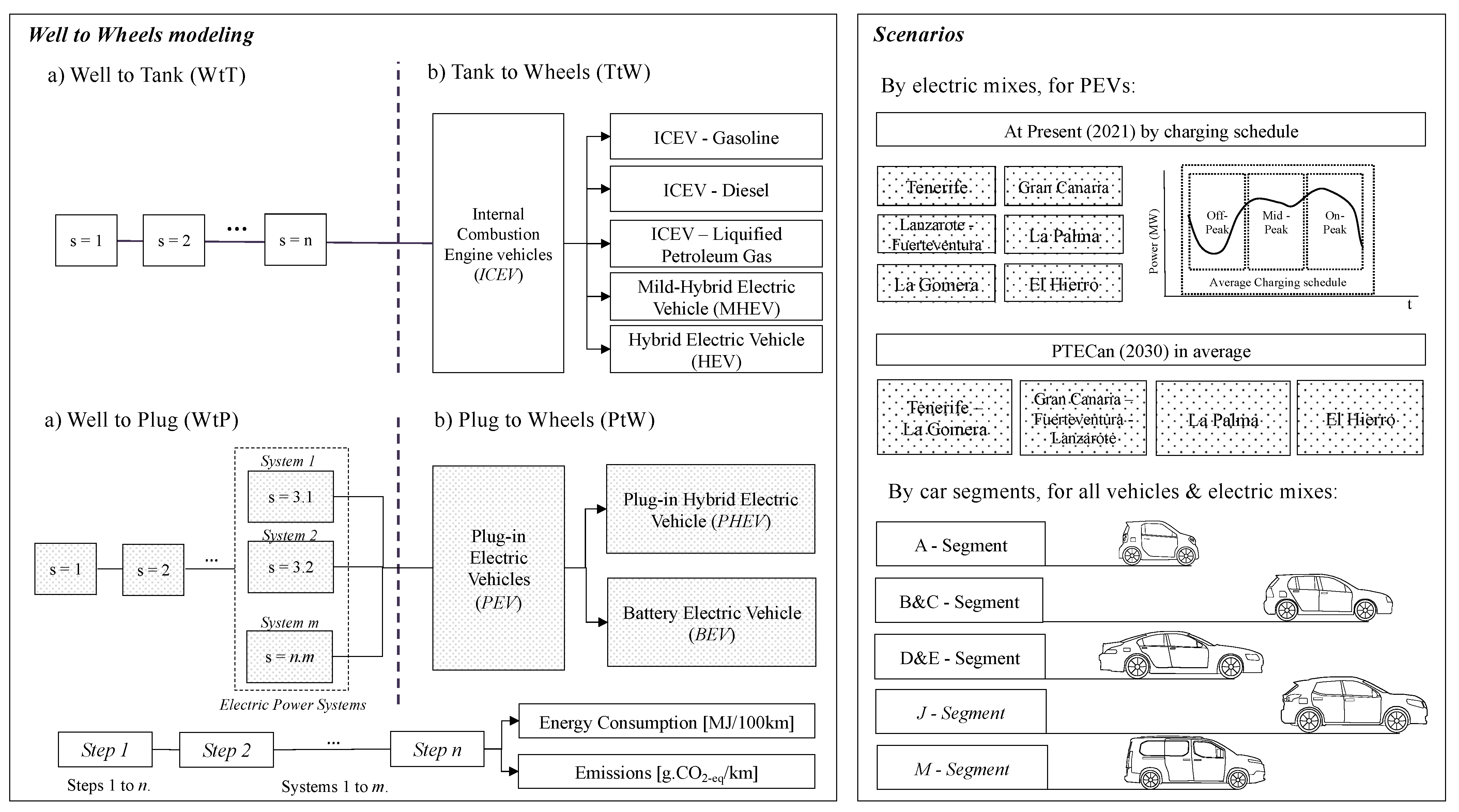
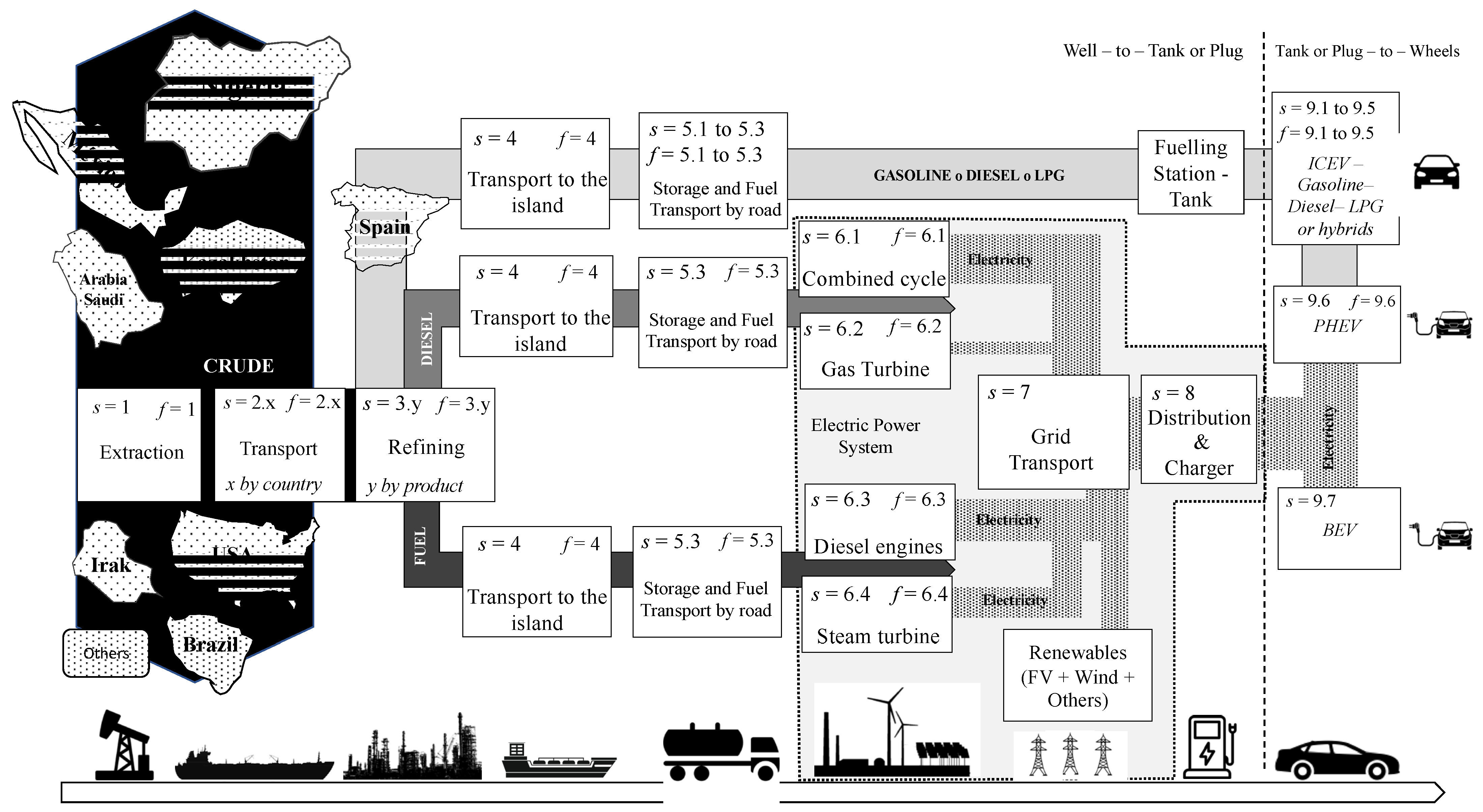
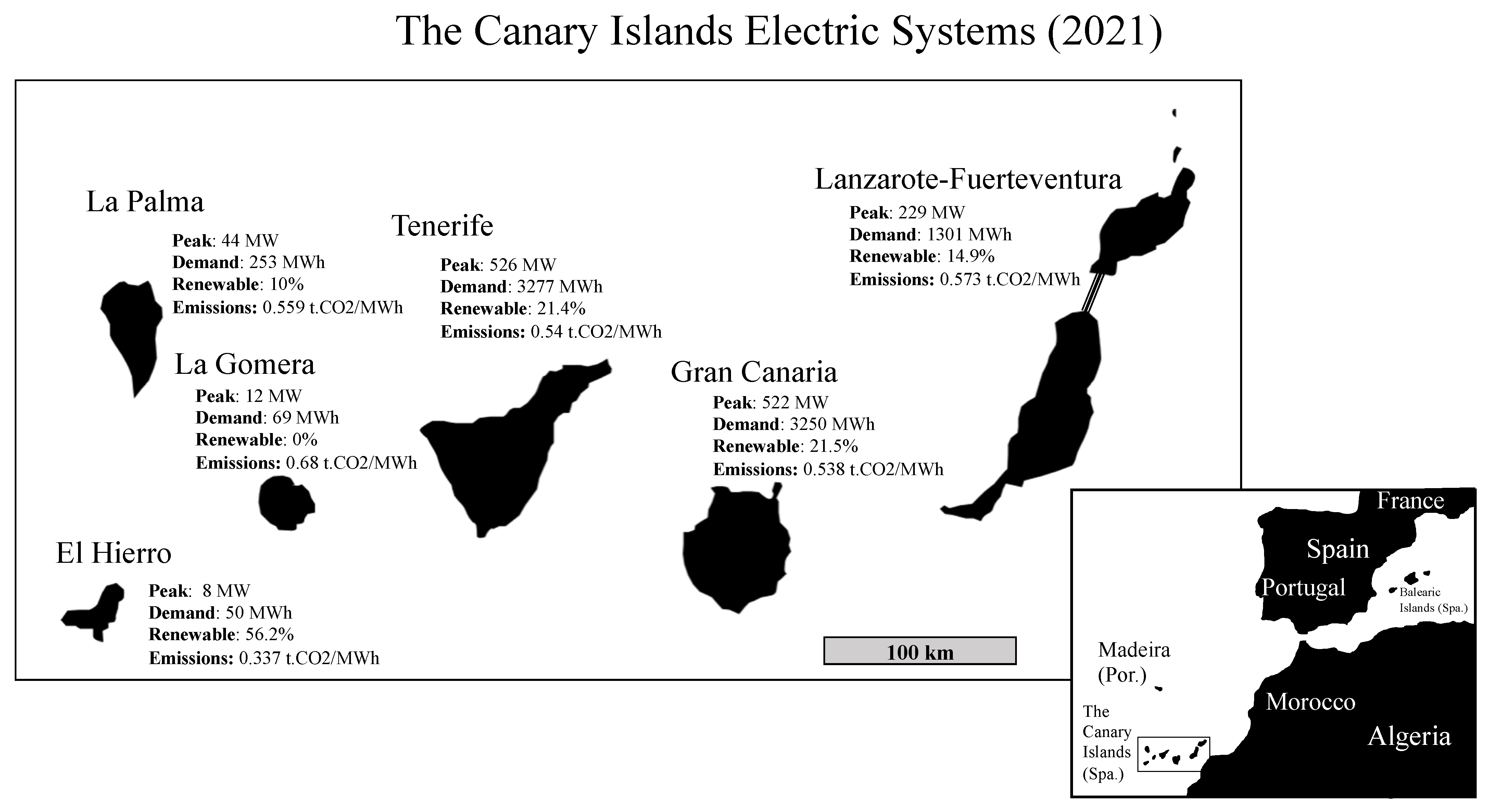

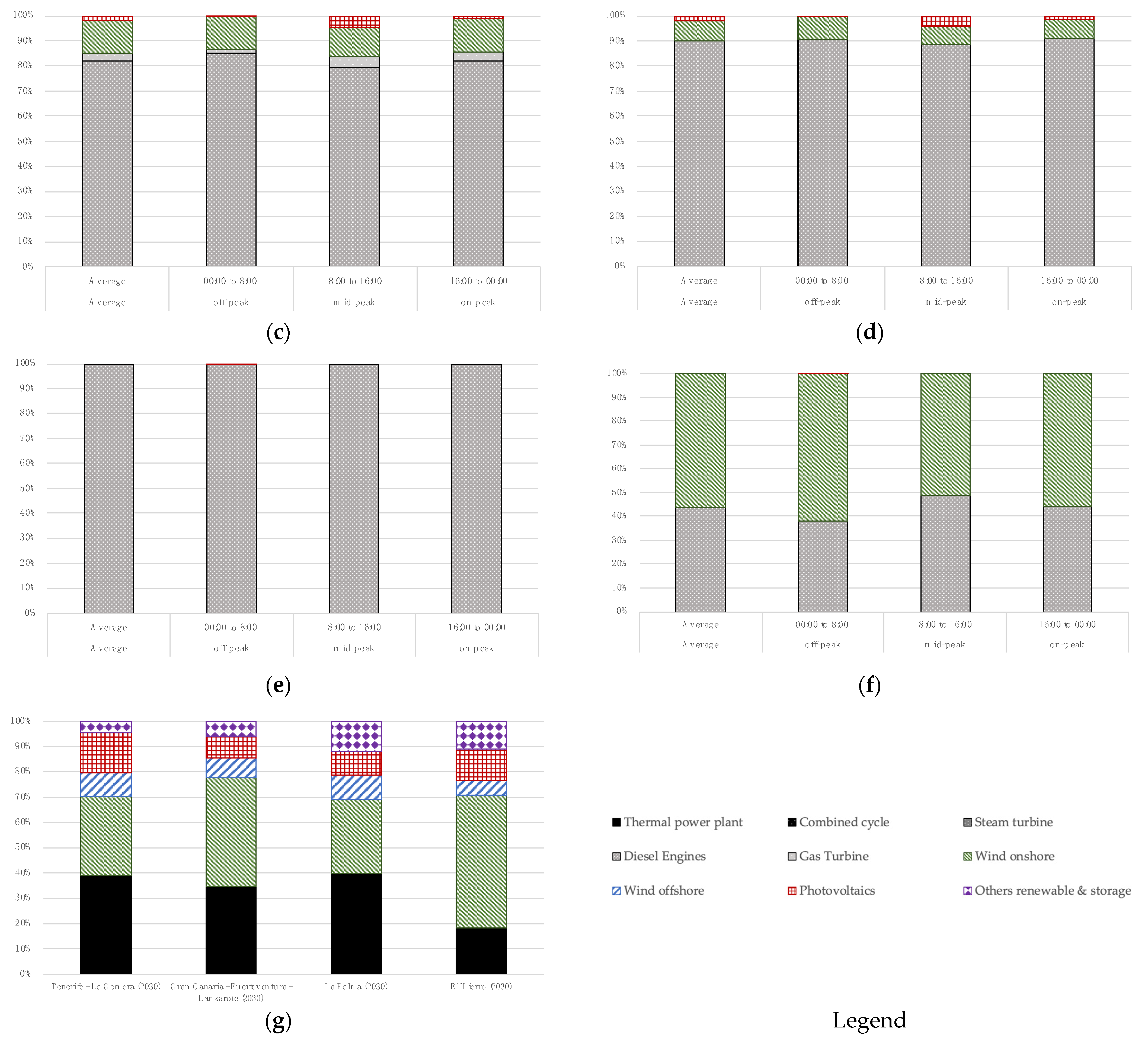
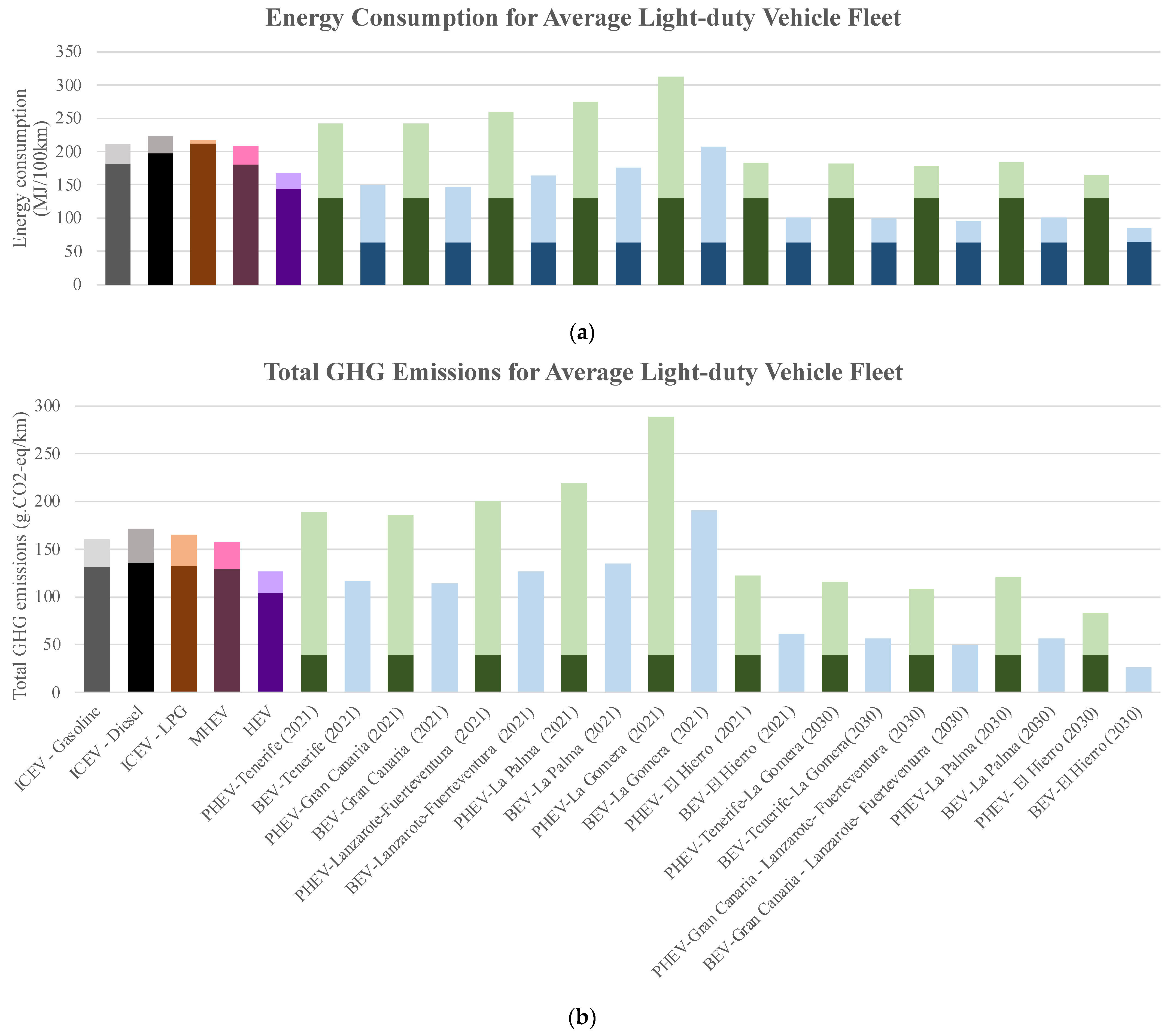
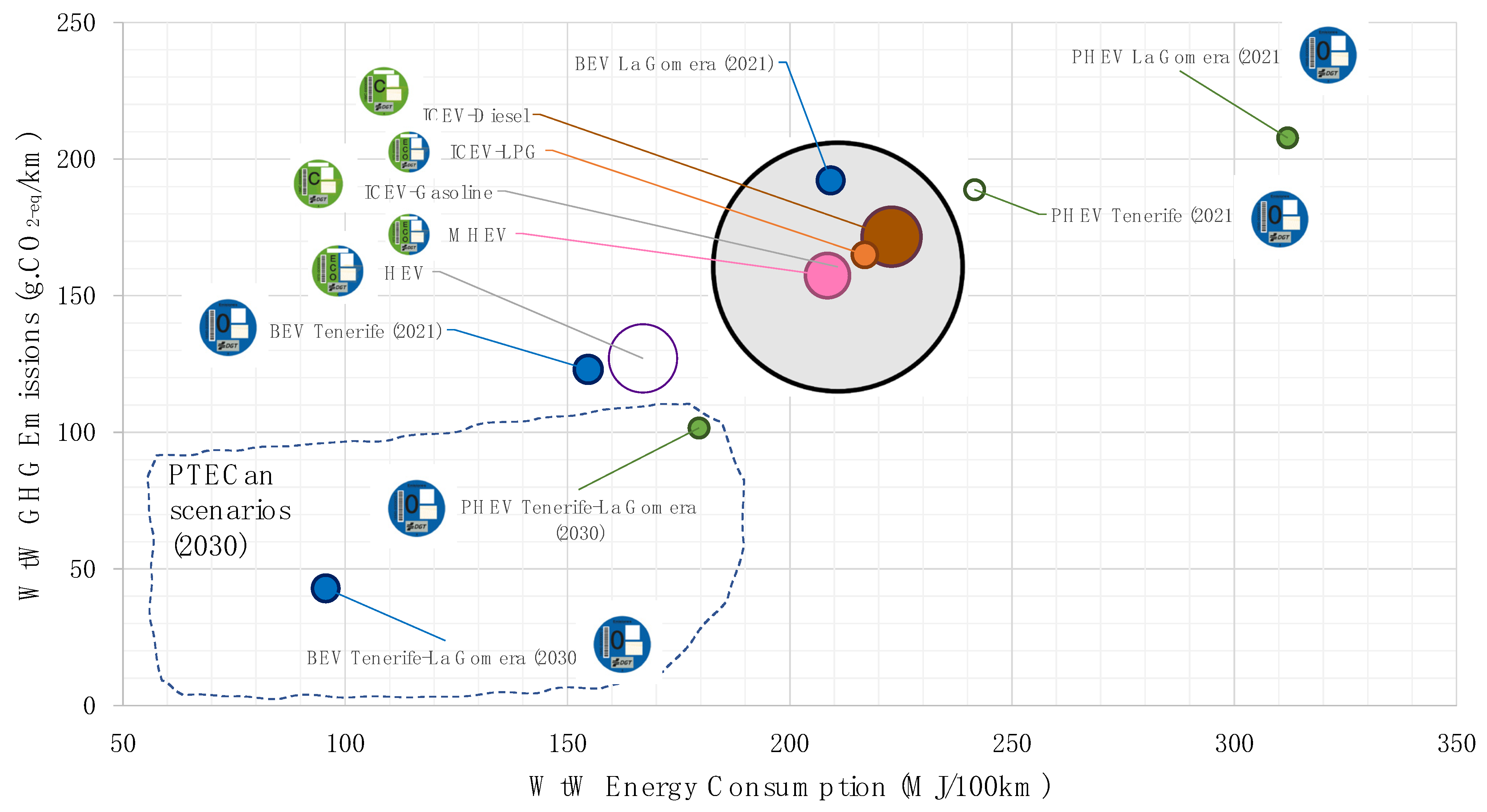
| Country | Share | Distance | Relative Energy Consumption (s = 2.x) (MJ/MJfuel) | Emissions in Transport (f = 2.x) (g CO2-eq/MJ) | ||
|---|---|---|---|---|---|---|
| % | (km) | Min (%) | Max (%) | Min (%) | Max (%) | |
| Nigeria | 20 | 6000 | 0.4 | 1.3 | 0.3 | 1 |
| Mexico | 15 | 9000 | 0.7 | 1.9 | 0.5 | 1.4 |
| Arabia Saudi | 10 | 4000 | 0.3 | 0.8 | 0.2 | 0.6 |
| Kazakhstan | 8 | 9000 | 0.7 | 1.9 | 0.5 | 1.3 |
| Iraq | 6 | 5500 | 0.4 | 1.2 | 0.3 | 0.8 |
| USA | 6 | 9000 | 0.7 | 1.9 | 1.4 | 1.3 |
| Brazil | 5 | 6500 | 0.5 | 1,4 | 0.3 | 1 |
| Rest of countries | 30 | 9000 | 0.7 | 1.9 | 0.5 | 1.3 |
| Energy Portion from 1 TOE (%) | Energy Efficiency (%) Associated to the Refining of the Product (s = 3.y) | Emissions Associated to the Refining of Products (s = 3.y) in g CO2-eq/MJfuel | |
|---|---|---|---|
| Min–Max | Min–Max | Min–Max | |
| Gasoline | 44.2–47.0 | 92.2–89.3 | 9.0–8.0 |
| Diesel/Gas oil | 26.1–29.5 | 95.6–93.1 | 13.0–9.0 |
| Fuel oil | 2.5–4.2 | 96.2–95.0 | 28.0–3.2 |
| LPG | 3.7–4.1 | 94.0–96.0 | 4.0–3.6 |
| Island System | Charging Schedule | Emission Rate | Grid Losses (%) 1 |
|---|---|---|---|
| - | - | t.CO2-eq/MWh | Min–Max. |
| Current (2021) | |||
| Tenerife | Average | 0.540 | 7%–8% |
| off-peak | 0.575 | ||
| mid-peak | 0.494 | ||
| on-peak | 0.494 | ||
| Gran Canaria | Average | 0.538 | 5%–6% |
| off-peak | 0.545 | ||
| mid-peak | 0.526 | ||
| on-peak | 0.547 | ||
| Fuerteventura–Lanzarote | Average | 0.573 | 5%–7% |
| off-peak | 0.573 | ||
| mid-peak | 0.568 | ||
| on-peak | 0.579 | ||
| La Palma | Average | 0.559 | 7%–8% |
| off-peak | 0.606 | ||
| mid-peak | 0.589 | ||
| on-peak | 0.605 | ||
| La Gomera | Avg, off, mid, on peak | 0.680 | 7%–8% |
| El Hierro | Average | 0.337 | 4%–5% |
| off-peak | 0.315 | ||
| mid-peak | 0.352 | ||
| on-peak | 0.340 | ||
| PTECan (2030) | |||
| Tenerife–La Gomera Avg. | 0.265 | 7%–8% | |
| Gran Canaria–Fuerteventura–Lanzarote Avg. | 0.237 | 5%–6% | |
| La Palma Avg. | 0.271 | 7%–8% | |
| El Hierro Avg. | 0.125 | 4%–5% | |
| Powertrain Technology 1 | ICEV Gasoline | ICEV Diesel | ICEV LPG | Mild HEV | HEV | PHEV | BEV | Total | |
|---|---|---|---|---|---|---|---|---|---|
| A-segment: Micro and urban vehicles | Avg. consumption 1 | 162.9 | - | 227.5 | 149.5 | 140.3 | - | 60.0 | 156.56 |
| Avg. emissions 2 | 117.6 | - | 142.3 | 108.3 | 101.6 | - | 0.0 | 110.86 | |
| Sample 3 | 1657 | - | 5 | 114 | 54 | - | 95 | 1925 | |
| B&C-segment: Compacts & midsize vehicles | Avg. consumption | 171.2 | 163.3 | 207.8 | 165.6 | 133.4 | 97.7 | 62.5 | 167.53 |
| Avg. emissions | 124.0 | 112.8 | 130.0 | 119.9 | 96.6 | 24.8 | 0.0 | 120.46 | |
| Sample | 15,811 | 389 | 86 | 369 | 962 | 27 | 233 | 17,877 | |
| D&E-segment: Large and family vehicles | Avg. consumption | 190.0 | 175.2 | 212.8 | 184.1 | 182.9 | 116.7 | 60.7 | 181.74 |
| Avg. emissions | 137.6 | 121.0 | 133.2 | 131.1 | 132.4 | 38.3 | 0.0 | 128.09 | |
| Sample | 493 | 413 | 18 | 32 | 262 | 30 | 3 | 1251 | |
| J-segment: All-road, crossovers, and SUVs | Avg. consumption | 191.6 | 213.1 | 209.9 | 190.4 | 144.4 | 135.9 | 66.7 | 186.86 |
| Avg. emissions | 138.8 | 147.1 | 133.2 | 135.6 | 104.4 | 41.4 | 0.0 | 135.47 | |
| Sample | 21,211 | 1069 | 336 | 847 | 1711 | 241 | 238 | 25,653 | |
| M-segment: MPVs, mini-VANs, VANs | Avg. consumption | 178.8 | 209.9 | 249.7 | - | 230.1 | - | 92.9 | 195.39 |
| Avg. emissions | 129.5 | 144.9 | 156.3 | - | 158.9 | - | 0.0 | 137.14 | |
| Sample | 511 | 483 | 32 | - | 4 | - | 4 | 1034 | |
| Average light-duty vehicle fleet | Avg. consumption | 182.1 | 197.4 | 212.5 | 180.1 | 144.3 | 130.5 | 64.0 | 178.98 |
| Avg. emissions | 131.9 | 136.3 | 133.0 | 128.9 | 104.4 | 39.6 | 0.0 | 128.14 | |
| Sample | 39,683 | 2354 | 477 | 1362 | 2993 | 298 | 570 | 47,740 | |
| Powertrain Technology | ICEV Gasoline | ICEV Diesel | ICEV LPG | Mild HEV | HEV | |
|---|---|---|---|---|---|---|
| A-segment: Micro and urban vehicles | Avg. consumption | 188.1 | - | 259.6 | 173.1 | 162.4 |
| Avg. emissions | 143.3 | - | 168.2 | 131.9 | 123.7 | |
| B&C-segment: Compacts & midsize vehicles | Avg. consumption | 198.2 | 184.5 | 237.2 | 191.8 | 154.5 |
| Avg. emissions | 151.0 | 142.1 | 153.6 | 146.1 | 117.7 | |
| D&E-segment: Large and family vehicles | Avg. consumption | 220.0 | 197.9 | 242.9 | 213.1 | 211.8 |
| Avg. emissions | 167.6 | 152.4 | 157.4 | 160.2 | 161.3 | |
| J-segment: All-road, crossovers, and SUVs | Avg. consumption | 221.9 | 240.7 | 239.6 | 220.4 | 167.2 |
| Avg. emissions | 169.1 | 185.4 | 155.2 | 165.6 | 127.2 | |
| M-segment: MPVs, mini-VANs, VANs | Avg. consumption | 207.1 | 237.0 | 285.0 | - | 266.4 |
| Avg. emissions | 157.8 | 182.6 | 184.7 | - | 195.2 | |
| Average light-duty vehicle fleet | Avg. consumption | 210.8 | 222.9 | 216.9 | 208.5 | 167.0 |
| Avg. emissions | 160.6 | 171.7 | 165.0 | 157.4 | 127.1 | |
| Island System 1 | Tenerife | Gran Canaria | |||
|---|---|---|---|---|---|
| Powertrain Technology | PHEV | BEV | PHEV | BEV | |
| A-segment: Micro and urban vehicles | Consumptions 2 Avg. [off; mid; on] | - | 139.6 [150.3; 128.4; 145.0] | - | 136.3 [138.3; 133.0; 138.2] |
| Emissions 3 Avg. [off; mid; on] | - | 109.2 [117.2; 99.3; 114.5] | - | 106.6 [107.8; 103.8; 108.3] | |
| B&C-segment: Compacts & midsize vehicles | Consumptions Avg. [off; mid; on] | 187.2 [198.5; 175.4; 193.0] | 145.5 [156.6; 133.8; 151.1] | 183.8 [185.8; 180.3; 185.8] | 142.1 [144.1; 138.6; 144.1] |
| Emissions Avg. [off; mid; on] | 145.5 [154.0; 135.1; 151.2] | 113.8 [122.1; 103.5; 119.4] | 142.8 [144.1; 139.8; 144.6] | 111.1 [112.3; 108.1; 112.9] | |
| D&E-segment: Large and family vehicles | Consumptions Avg. [off; mid; on] | 214.6 [226.7; 201.9; 220.7] | 141.3 [152.2; 130.0; 146.8] | 210.9 [213.1; 207.1; 213.1] | 138.0 [140.0; 134.6; 140.0] |
| Emissions Avg. [off; mid; on] | 169.7 [178.7; 158.5; 175.7] | 110.6 [118.7; 100.5; 116.0] | 166.7 [168.1; 163.5; 168.7] | 107.9 [109.2; 105.1; 109.7] | |
| J-segment: All-road, crossovers, and SUVs | Consumptions Avg. [off; mid; on] | 251.1 [265.4; 236.1; 258.3] | 155.3 [167.2; 142.8; 161.3] | 246.7 [249.3; 242.3; 249.3] | 151.7 [153.8; 148.0; 153.9] |
| Emissions Avg. [off; mid; on] | 196.0 [206.7; 182.8; 203.2] | 121.5 [130.4; 110.5; 127.5] | 192.5 [194.2; 188.8; 194.9] | 118.6 [120.0; 115.4; 120.5] | |
| M-Segment: MPVs, mini-VANs, VANs | Consumptions Avg. [off; mid; on] | - | 216.2 [232.8; 198.8; 224.6] | - | 211.1 [214.1; 206.0; 214.2] |
| Emissions Avg. [off; mid; on] | - | 169.1 [181.5; 153.8; 177.4] | - | 165.0 [167.0; 160.7; 167.8] | |
| Average light-duty vehicle fleet | Consumptions Avg. [off; mid; on] | 241.6 [255.4; 227.2; 248.6] | 149.1 [160.5; 137.1; 154.9] | 237.4 [239.9; 233.1; 239.9] | 145.6 [147.6; 142.0; 147.6] |
| Emissions Avg. [off; mid; on] | 188.8 [199.1; 176.0; 195.7] | 116.6 [125.1; 106.0; 122.3] | 185.4 [187.0; 181.8; 187.7] | 113.8 [115.1; 110.8; 115.6] | |
| Island System 1 | Fuerteventura–Lanzarote | La Palma | |||
|---|---|---|---|---|---|
| Powertrain Technology | PHEV | BEV | PHEV | BEV | |
| A-segment: Micro and urban vehicles | Consumptions 2 Avg. [off; mid; on] | - | 153.1 [155.0; 150.5; 154.4] | - | 165.0 [166.2; 162.0; 168.0] |
| Emissions 3 Avg. [off; mid; on] | - | 118.4 [118.9; 177.0; 119.7] | - | 126.2 [127.1; 123.7; 128.3] | |
| B&C-segment: Compacts & midsize vehicles | Consumptions Avg. [off; mid; on] | 201.5 [203.5; 198.8; 202.9] | 159.6 [161.6; 157.0; 160.9] | 214.1 [215.3; 210.9; 217.2] | 172.0 [173.2; 168.8; 175.1] |
| Emissions Avg. [off; mid; on] | 155.3 [155.8; 153.8; 156.7] | 123.4 [123.9; 122.0; 124.8] | 210.7 [164.4; 160.9; 165.7] | 131.5 [132.4; 129.0; 133.7] | |
| D & E–segment: Large and family vehicles | Consumptions Avg. [off; mid; on] | 229.9 [232.1; 227.0; 231.4] | 155.0 [156.9; 152.4; 156.3] | 243.4 [244.7; 240.0; 246.7] | 167.1 [168.2; 164.0; 170.1] |
| Emissions Avg. [off; mid; on] | 180.1 [180.7; 178.5; 181.6] | 119.9 [120.4; 118.5; 121.2] | 163.5 [189.9; 186.1; 191.3] | 127.8 [128.6; 125.3; 129.9] | |
| J–segment: All-road, crossovers, and SUVs | Consumptions Avg. [off; mid; on] | 269.2 [271.7; 265.8; 270.8] | 170.4 [172.5; 167.5; 171.8] | 285.0 [286.6; 281.0; 289.0] | 183.6 [184.9; 180.2; 186.9] |
| Emissions Avg. [off; mid; on] | 208.3 [209.0; 206.5; 210.1] | 131.7 [132.3; 130.2; 133.2] | 188.9 [219.9; 215.4; 221.5] | 140.4 [141.3; 137.7; 142.7] | |
| M-Segment: MPVs, mini-VANs, VANs | Consumptions Avg. [off; mid; on] | - | 237.2 [240.1; 233.2; 239.1] | - | 255.5 [257.4; 250.8; 260.1] |
| Emissions Avg. [off; mid; on] | - | 183.4 [184.2; 181.2; 185.5] | - | 195.5 [196.7; 191.7; 198.6] | |
| Average light-duty vehicle fleet | Consumptions Avg. [off; mid; on] | 259.1 [261.5; 255.8; 260.7] | 163.5 [165.5; 160.8; 164.9] | 274.4 [275.9; 270.5; 278.2] | 176.2 [177.4; 173.0; 179.4] |
| Emissions Avg. [off; mid; on] | 200.7 [201.4; 198.9; 202.4] | 126.4 [127.0; 125.0; 127.9] | 218.7 [211.8; 207.6; 213.4] | 134.8 [135.6; 132.1; 137.0] | |
| Island System 1 | La Gomera | El Hierro | |||
|---|---|---|---|---|---|
| Powertrain Technology | PHEV | BEV | PHEV | BEV | |
| A-segment: Micro and urban vehicles | Consumptions 2 Avg. [off; mid; on] | - | 194.2 - | - | 94.6 [90.0; 98.9; 94.9] |
| Emissions 3 Avg. [off; mid; on] | - | 178.4 - | - | 57.7 [50.0; 64.2; 58.1] | |
| B&C-segment: Compacts & midsize vehicles | Consumptions Avg. [off; mid; on] | 244.9 - | 202.4 - | 139.7 [134.8; 144.3; 140.0] | 98.6 [93.8; 103.1; 98.9] |
| Emissions Avg. [off; mid; on] | 278.1 - | 186.0 - | 91.1 [83.1; 98.0; 91.5] | 60.1 [52.2; 66.9; 60.5] | |
| D&E-segment: Large and family vehicles | Consumptions Avg. [off; mid; on] | 276.5 - | 196.6 - | 163.6 [158.4; 168.5; 163.9] | 95.8 [91.1; 100.2; 96.0] |
| Emissions Avg. [off; mid; on] | 218.7 - | 180.7 - | 111.2 [102.7; 118.7; 111.7] | 58.4 [50.7; 65.0; 58.8] | |
| J-segment: All-road, crossovers, and SUVs | Consumptions Avg. [off; mid; on] | 324.0 - | 216.1 - | 191.0 [184.8; 196.8; 191.3] | 105.3 [100.1; 110.1; 105.5] |
| Emissions Avg. [off; mid; on] | 248.1 - | 198.5 - | 127.2 [117.1; 135.9; 127.7] | 64.1 [55.7; 71.42; 64.6] | |
| M-segment: MPVs, mini-VANs, VANs | Consumptions Avg. [off; mid; on] | - | 300.8 - | - | 146.5 [139.3; 153.2; 146.9] |
| Emissions Avg. [off; mid; on] | - | 276.4 - | - | 89.3 [77.6; 99.4; 89.9] | |
| Average light-duty vehicle fleet | Consumptions Avg. [off; mid; on] | 312.0 - | 207.8 - | 183.6 [177.7; 189.2; 183.9] | 101.0 [96.1; 105.6; 101.3] |
| Emissions Avg. [off; mid; on] | 288.5 - | 190.5 - | 122.3 [112.6; 130.7; 122.8] | 61.6 [53.5; 68.6; 62.0] | |
| Isolated System | Tenerife–La Gomera | Gran Canaria–Fuerteventura–Lanzarote | La Palma | El Hierro | |||||
|---|---|---|---|---|---|---|---|---|---|
| Powertrain Technology | PHEV | BEV | PHEV | BEV | PHEV | BEV | PHEV | BEV | |
| A-segment: Micro and urban | Consumptions 1 | - | 93.6 | - | 90.6 | - | 94.8 | - | 79.8 |
| Emissions 2 | - | 52.9 | - | 46.5 | - | 52.9 | - | 24.5 | |
| B&C-segment: Compacts & midsize | Consumptions | 138.7 | 97.6 | 135.5 | 94.4 | 139.9 | 98.8 | 124.1 | 83.1 |
| Emissions | 86.1 | 55.2 | 79.3 | 48.5 | 116.3 | 55.2 | 79.6 | 25.6 | |
| D&E-segment: Large and family | Consumptions | 162.5 | 94.8 | 159.1 | 91.7 | 163.8 | 96.0 | 146.9 | 80.8 |
| Emissions | 105.9 | 53.6 | 98.7 | 47.1 | 86.1 | 53.6 | 56.1 | 24.9 | |
| J-segment: All-road, crossovers, and SUVs | Consumptions | 189.7 | 104.2 | 185.6 | 100.8 | 191.2 | 105.5 | 171.3 | 88.8 |
| Emissions | 120.9 | 53.6 | 112.4 | 51.7 | 105.9 | 58.9 | 73.8 | 27.3 | |
| M-segment: MPVs, mini-VANs, VANs | Consumptions | - | 145.0 | - | 140.3 | - | 146.8 | - | 123.6 |
| Emissions | - | 58.9 | - | 72.0 | - | 82.0 | - | 38.0 | |
| Average light-duty vehicle fleet | Consumptions | 182.4 | 100.0 | 178.4 | 96.7 | 183.8 | 101.2 | 164.5 | 85.2 |
| Emissions | 116.2 | 56.5 | 108.0 | 49.7 | 120.9 | 56.5 | 83.0 | 26.2 | |
Disclaimer/Publisher’s Note: The statements, opinions and data contained in all publications are solely those of the individual author(s) and contributor(s) and not of MDPI and/or the editor(s). MDPI and/or the editor(s) disclaim responsibility for any injury to people or property resulting from any ideas, methods, instructions or products referred to in the content. |
© 2023 by the authors. Licensee MDPI, Basel, Switzerland. This article is an open access article distributed under the terms and conditions of the Creative Commons Attribution (CC BY) license (https://creativecommons.org/licenses/by/4.0/).
Share and Cite
Ramírez-Díaz, A.J.; Ramos-Real, F.J.; Barrera-Santana, J. Well-to-Wheels for Light-Duty Vehicle Powertrains by Segments in Isolated Systems. Energies 2023, 16, 1018. https://doi.org/10.3390/en16031018
Ramírez-Díaz AJ, Ramos-Real FJ, Barrera-Santana J. Well-to-Wheels for Light-Duty Vehicle Powertrains by Segments in Isolated Systems. Energies. 2023; 16(3):1018. https://doi.org/10.3390/en16031018
Chicago/Turabian StyleRamírez-Díaz, Alfredo J., Francisco J. Ramos-Real, and Josue Barrera-Santana. 2023. "Well-to-Wheels for Light-Duty Vehicle Powertrains by Segments in Isolated Systems" Energies 16, no. 3: 1018. https://doi.org/10.3390/en16031018
APA StyleRamírez-Díaz, A. J., Ramos-Real, F. J., & Barrera-Santana, J. (2023). Well-to-Wheels for Light-Duty Vehicle Powertrains by Segments in Isolated Systems. Energies, 16(3), 1018. https://doi.org/10.3390/en16031018







